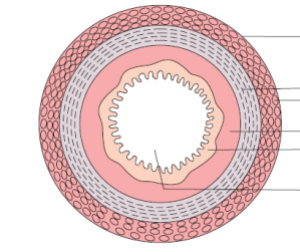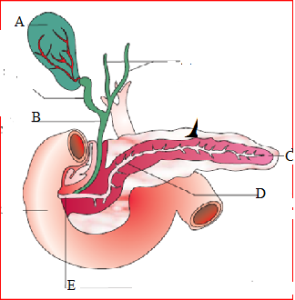Digestion and Absorption
Q1.What is the dental formula of human being?
a)2123/2123
b)2123/2213
c)2114/2114
d)2122/2122
Q2.Which one serves as a passage for both food and air?
a)Larynx
b)Pharynx
c)Gullet
d)Glottis
Q3.Bile juice is stored in which organ of human body?
a)Gall bladder
b)Liver
c)Kidney
d)Pancreas
Q4.Which one of the following sequence is in correct order?
a)Descending portal colon→Rectum→Anus
b)Colon→Anus→Rectum
c)Stomach→Jejunum→Duodenum
d)Ileum→Colon→Caecum
Q5.Given below the diagram of the transverse section of alimentary canal.Label it correctly and Choose the correct option accordingly.
 A
A
B
C
D E
a)A-Muscularis B-Serosa C-Submucosa D-Mucosa
b)A- Muscularis B-Serosa C-Mucosa D-Submucosa
c)A-Serosa B-Muscularis C-Mucosa D-Submucosa
d) A- Serosa B- Muscularis C-Submucosa D-Mucosa
Q6.How many salivary glands are present in human being?
a)6
b)10
c)8
d)12
Q7.Which one of the following is regarded as source of instant energy?
a)Fats
b)Carbohydrates and Fats
c)Carbohydrates only
d)Minerals and Vitamins
Q8.The innermost layer of human gut forms irregular folds in the stomach which are known as
a)lumen
b)villi
c)rugae
d)Both b) and c)
Q9.Common bile duct is formed by the fusion of
a)pancreatic duct and cystic duct
b)pancreatic duct and hepatic duct
c)pancreaticduct,hepatic duct and cystic duct
d)hepatic duct and cystic duct
Q10Which one is not associated with the secretion of saliva in human beings?
a)Parotids glands
b)Sublingual glands
c)Zymogenic cells
d)Submaxillary glands
Q11.Which enzyme is present in human saliva?
a)Ptylin
b)Pepsin
c)Enterokinase
d)Maltase
Q12. The diagram of large intestine of man is given below.Identify the parts labelled A, B, C, D, E and F

a)A=caecum,B=Vermiform appendix,C=Ascending colon,D=Transverse colon,E=Descending colon,
b) F=caecum,B=Vermiform appendix,E=Ascending colon,D=Transverse colon,C=Descending colon,
c) F=caecum,B=Vermiform appendix,C=Ascending colon,D=Transverse colon,E=Descending colon,
d) A=caecum,B=Vermiform appendix,D=Ascending colon,E=Transverse colon,F=Descending colon,
Q13.A large lymph vessel present in the villus of small intestine is called
a)crypts
b)lacteal
c)Peyer’s patches
d)valve of kerkring
Q14.Which of the following match is correct?
a)Renin-Protein
b)Trypsin-starch
c)Invertase-Sucrase
d)Amylase-Lactose
Q15.Match the following columns
| Column -I | Column-II |
| a-Salivary amylase | 1. Proteins |
| b -Bile salts | 2. Milk protein |
| c-Renin | 3. starch |
| d-Pepsin | 4. Lipids |
| e-Steapsin | 5. Emulsification of fats |
a) 5 4 1 2 3
b) 3 5 2 1 4
c) 2 3 5 4 1
d) 2 3 4 5 1
Q16.Which one of the following sugar is most rapidly absorbed in the human gut.?
a)Glucose
b)Fructose
c)Galactose
d)Sucrose
Q17.Select the true statement regarding the digestion and absorption of food in humans.
a)Oxyntic cell in human stomach secretes proenzymes,pepsinogen and trypsinogen
b)Chylomicrons are small lipoprotein vesicles which are transported from the intestine into blood capillaries.
c)About 70% of the starch is hydrolysed by salivary amylase.
d)Fructose and aminoacids are absorbed through the intestinal mucosa with the help of carrier ions like Na+
Q18.Absorption of fat occours through the process of
a)active transport
b)passive transport
c)osmosis
d)simple diffusion
Q19.What is common among amylase,renin and trypsin?
a)all are produced in stomach
b)all act at a pH lower than 7
c)all are proteins
d)all are proteolytic enzymes
Q20.What name would you suggest for a thoroughly mixed food with gastric juices by the churning movements of muscular stomach wall?
a)Bolus
b)Chyme
c)Either bolus or chime
d)none of these
Q21.Which is the inactive form of enzyme,pepsin?
a)Pepsinogen
b)Protease
c)Trypsin
d)Peptones
Q22.Pepsinogen is converted into active form of enzyme pepsin with the help of which of the following compound?
a)Proenzyme
b)Hydrochloric acid
c)Electrolyte
d)Bicarbonates
Q23.Which enzyme is responsible for the digestion of milk in infants?
a)Pepsin
b)Trypsin
c)Renin
d)various proteolytic enzyme
Q24.Maximum absorption of water occours in
a)caecum
b)colon
c)small intestine
d)large intestine
Q25.Succus entericus is secreted by
a)Goblet cells
b)Crypts of Lieberkuhn
c)Islets of lengerhans
d)Paneth cell
Q26.What is the composition of bile?
a)bile pigment and bile salts
b)bile pigments and cholesterol
c)cholesterol and phospholipids
d)All the above
Q27.Which of the following present in the filiform papillae of the tongue?
a)chemoreceptors
b)thermoreceptors
c)tactile receptors
d)taste buds
Q28.The gastric juice contain
a)trypsin,renin,pepsin
b)pepsin,trypsin,amylase
c)pepsin ,renin,
d)trypsin,pepsin,lipase
Q29.Fill in the blanks with appropriate options to complete the given equation
Fats—– A—àB—pancreatic lipase_–>Monoglycerides +Fatty acids
a)A-Lysozyme, B-Polyglycerides
b)A-Lysozyme, B-Diglycerides
c)A-Lipase , B)Diglycerides
d)A-Lipase B)Polyglycerides
Q30.Bile salt activates which enzyme?
a)Lipase
b)pancreatic amylase
c)Pepsinogen
d)Trypsinogen
Q31.Choose the incorrect statement regarding human digestive system with reference to a normal person.
a)human saliva is slightly acidic
b)In human being, four pair of salivary gland secretes saliva
c)The quantity of saliva in adult man may be 1 to 1.5L day
d)Enzyme amylase present in saliva is responsible for the break down of starch into simpler sugar
Q32.The given below diagram represents a duct system of pancreas,liver and gall bladder.Label the diagram from A to E.

a)A-Gall bladder, B-common bile duct, C-Hepato pancreatic duct D-Pancreas E-Pancreatic duct
b) A-Gall bladder, B- bile duct, C-Hepato pancreatic duct D-Pancreatic duct E-Pancreas
c) A-Gall bladder, B- bile duct, E-Hepato pancreatic duct C-Pancreatic duct D-Pancreas
d) A-Gall bladder, B-common bile duct, E-Hepato pancreatic duct D-Pancreatic duct C-Pancreas
Q33.Which form of fats is absorbed into the intestinal cells?
a)micelles
b)chylomicrons
c)fatty acids
d)both a) and b)
Q34.Function of caecum is to carryout digestion of
a)starch
b)proteins
c)cellulose
d)fats
Q35.Part of the stomach which opens into the duodenum?
a)cardiac
b)pyloric
c)fundus
d)body
Q36.Which is the hardest material of the human body?
a)Dentine
b)Enamel
c)Teeth
d)Bone
Q37.Which one of the following pairs of food components in humans reaches the stomach totally undigested
a)starch and cellulose
b)protein and starch
c)starch and fat
d)fat and cellulose
Q38.A young infant may be feeding entirely on mother’s milk which is white in colour but he possesses yellowish coloured stools.What is this yellow colour due to?
a)Pancreatic juice poured into duodenum
b)Intestinal juice
c)Bile pigments passed through bile juice
d)Undigested milk protein casein.
Q39.The absorption of water,alcohol and monosaccharidesoccour in
a)gastric mucosa
b)mucosa of ileum
c)intestinal mucosa
d)none of the above
Q40.Select what is not true of intestinal villi among followings:
a)They possesses microvilli
b)They increase the surface area
c)They are supplied with capillaries and the lacteal vessels
d)They only participate in digestion of fats
Q41.Hepatopancreatic duct opens into the duodenum and carries
a)Bile
b)Pancreatic juice
c)both bie and pancreatic juice
d)saliva
Q42.One of the following is not a common disorder associated with digestive system:
a)Tetanus
b)Diarrhoea
c)Jaundice
d)Dysentery
Q43.Which one of the following is a non reducing carbohydrate?
a)Maltose
b)Sucrose
c)Lactose
d)Ribose 5 –phosphate
Q44.Where do certain symbiotic microorganisms normally occour in human body?
a)Caecum
b)oral lining and toungue surface
c)Vermiform appendix and rectum
d)Duodenum
Q45.What is the another name of gastro oesophageal sphincter?
a)pyloric sphincter
b)gastro duodenal sphincter
c)cardiac sphincter
d)sphincter of oddi
Q46.In humans,which opening is guarded by sphincter of Oddi?
a)Opening of hepatopancreatic ampulla into duodenum
b)Opening of stomach into duodenum
c)Opening of oesophagus into stomach
d)Opening of bile duct into gall bladder
Q47.The epithelium of the mucosa remain unaffected from HCl due to
a)Mucous continues to lubricate the inner lining
b)bicarbonates present in the gastric juices protect the linings
c)both a) and b)
d)none of the above
Q48.Which of the following cells produce HCl ?
a)B-cell
b)α-cell
c)Oxyntic cell
d)Chief cell
Q49.What is frenulum?
a)It is the fold by which tongue is attached to the floor of oral cavity
b)it is an adenoid which is present on pharyngeal wall
c)it is a tonsil like structure
d)it is a V-shaped furrow which divides the surface of tongue.
Q50.Thecodont,diphyodont and heterodont teeth are characterstic of
a)Aves
b)Reptiles
c)Mammals
d)Amphibians
ANSWER KEY
1-a,2-b,3-a,4-a,5-d,6-a,7-c,8-c,9-d,10-c,11-a,12-a,13-b,14-c,15-b,16-c,17-b,18-d,19-c,20-b,21-a, 22-b,23-c,24-b,25-b,26-d,27-c,28-c,29-c,30-a,31-b,32-d,33-a,34-c,35-b,36-b,37-d,38-c,39-a,40-d,41-c 42-a,43-b,44-a,45-c,46-a,47-c,48-c,49-a,50-c